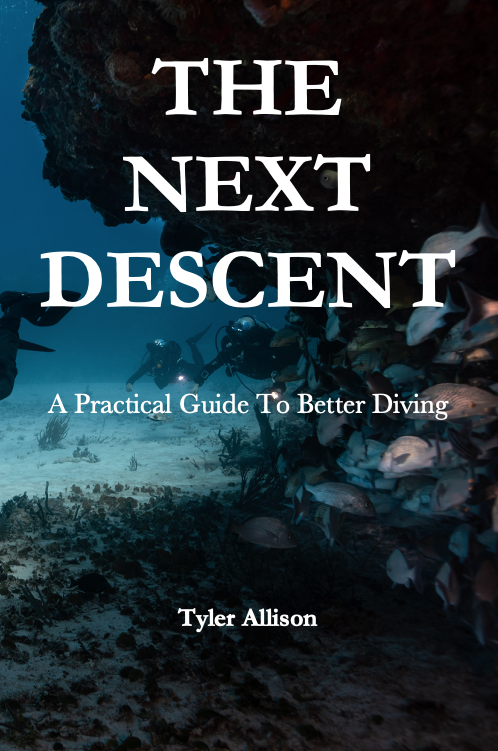The Next Descent
This book is for divers with roughly 5 to 100 dives who want to move beyond basic certification and become truly capable. It focuses on practical techniques, smarter gear decisions, and a mindset that supports safe, confident dives. The aim is simple: help recreational divers build precision, awareness, and judgment they can use on every dive.

Release Information
Status: Manuscript Draft
Formats: Paperback and eBook
Release Date: Late 2026
For divers with 5 to 100 dives, this book bridges the gap between being certified and becoming truly capable. It offers practical, experience-based advice to help you refine your skills, make smarter gear decisions, and grow into a confident, safety-minded diver.
Chapter Previews
Chapter 1 - Certified Is Not the Same as Skilled
Challenges the idea that a certification card equals mastery. Introduces the growth mindset and normalizes the reality that diving skill develops slowly, through experience and reflection.
Chapter 2 - The First 100 Dives: A Roadmap to Growth
Breaks the early journey into practical milestones: dives 5 to 25, 25 to 50, and 50 to 100. Suggests specific types of dives to seek out, skills to revisit, and how to make experience count.
Chapter 3 - Buoyancy, Trim, and Control: Getting Precise
Shows how to refine the most important underwater skillset, including body position, stillness, and subtle adjustments. Includes simple drills and coaching cues to improve control.
Chapter 4 - Streamlining, Breathing, and Movement Efficiency
Helps reduce drag, improve air consumption, and move with less effort. Encourages divers to become more aware of their energy use and develop smoother, more efficient motion underwater.
Chapter 5 - Situational Awareness and Good Buddy Behavior
Builds the habits that make you a dependable and enjoyable dive partner. Teaches calm observation, communication, and mutual support in varied diving conditions.
Chapter 6 - Getting Beyond "Just Dive More"
Teaches divers to replace vague advice with intentional learning. Covers setting goals, reflecting after dives, and tracking progress in a way that accelerates growth.
Chapter 7 - When to Take Another Class (and When Not To)
Helps evaluate whether a course will truly improve skills or simply add another card. Encourages a value-based approach to continuing education.
Chapter 8 - How to Evaluate a Good Instructor or Course
Goes beyond ratings and credentials. Provides the right questions to ask, what to observe, and how to recognize an instructor or program that will actually meet your needs.
Chapter 9 - The Agency Question: What Actually Matters
Explains practical differences between training agencies without bias or tribalism. Emphasizes that the quality of instruction outweighs agency branding.
Chapter 10 - Understanding the Core Gear Categories
Gives a clear overview of major gear types, including regulators, BCDs, tanks, exposure protection, and computers. Explains what each does and why design differences matter.
Chapter 11 - Common Gear Mistakes and Regrets
Outlines avoidable errors such as poor fit, buying on bad advice, overspending, or chasing unnecessary upgrades. Shows how to make purchases you will not regret later.
Chapter 12 - Building a Gear Setup That Works for You
Guides the creation of a complete, adaptable gear system that suits your dive style and local conditions. Focuses on function over fashion or trends.
Chapter 13 - Tools, Spares, and the Essentials No One Tells You About
Introduces lesser-known accessories that make diving smoother and safer, from cutting tools and clips to lights, bags, and spares.
Chapter 14 - Should You Rent or Own? Travel or Local?
Helps decide whether to rent or buy gear based on your diving habits. Encourages a lifestyle approach that balances skill building, enjoyment, and practicality.
Chapter 15 - How to Evaluate Dive Boats, Shops, and Destinations
Provides tools to identify safe, professional, and enjoyable dive operations. Includes questions to ask and signs that a destination or provider may not be a good fit.
Chapter 16 - Planning Dives with Confidence (and What to Do When Things Go Sideways)
Builds core dive planning skills and introduces simple contingency thinking. Prepares divers to adapt when conditions change or unexpected problems occur.
Chapter 17 - Writing Your Own Dive Code of Conduct
Encourages defining personal standards for safety, teamwork, and decision making. Clarifies how you want to behave and when you will choose not to dive.
Chapter 18 - The Mental Side of Diving: Confidence, Fear, and Growth
Helps recognize and address anxiety, self doubt, and external pressure. Validates the emotional aspects of becoming skilled and staying engaged in diving.
Chapter 19 - How to Keep Getting Better Without Getting Bored
Offers ways to keep diving fresh and challenging over time, from exploring new environments to mentoring others or joining volunteer projects.
Chapter 20 - Bad Divers, Bad Culture, and What to Do About It
Shows how to identify toxic behavior, ego driven attitudes, and unsafe practices. Encourages setting boundaries and finding healthy dive communities.
Chapter 21 - Your Dive Journey: What Comes Next
Encourages reflection on your progress and choices for the future. Reinforces that you are now an active diver with the ability to shape your own path.
Chapter 22 - Should I Go Tech? An Honest Look at What is Next
Offers a realistic overview of technical diving and advanced paths. Explains what it involves, who thrives in it, and the costs in time, money, and commitment.
Appendix - Practical Gas Planning (Without the Math Degree)
Introduces the core concepts of gas planning in a clear, non technical way. Focuses on safety margins, situational thinking, and practical application for recreational dives.